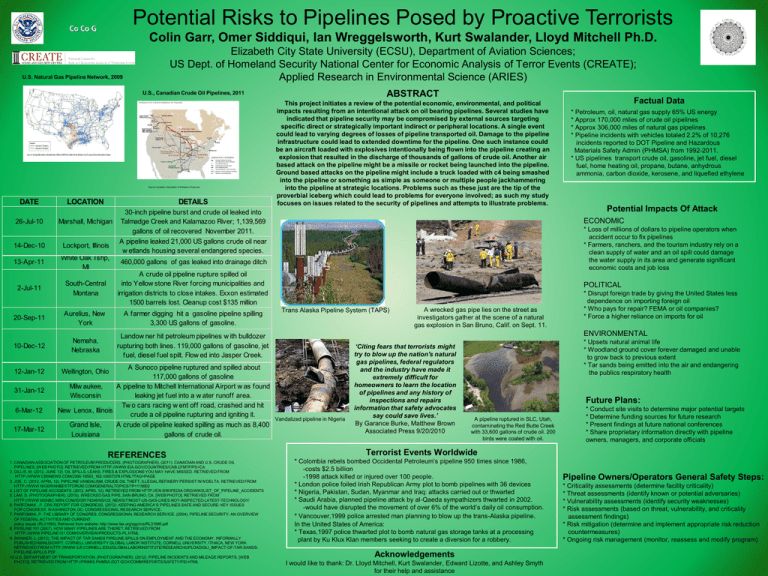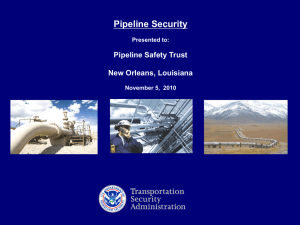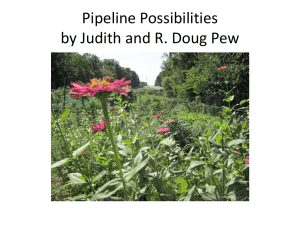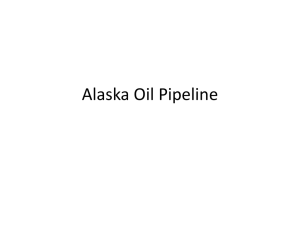Poster - aries
advertisement

Potential Risks to Pipelines Posed by Proactive Terrorists Colin Garr, Omer Siddiqui, Ian Wreggelsworth, Kurt Swalander, Lloyd Mitchell Ph.D. Elizabeth City State University (ECSU), Department of Aviation Sciences; US Dept. of Homeland Security National Center for Economic Analysis of Terror Events (CREATE); Applied Research in Environmental Science (ARIES) U.S. Natural Gas Pipeline Network, 2009 ABSTRACT U.S., Canadian Crude Oil Pipelines, 2011 Source: Canadian Association of Petroleum Producers DATE 26-Jul-10 14-Dec-10 13-Apr-11 2-Jul-11 LOCATION DETAILS 30-inch pipeline burst and crude oil leaked into Marshall, Michigan Talmadge Creek and Kalamazoo River; 1,139,569 gallons of oil recovered November 2011. A pipeline leaked 21,000 US gallons crude oil near Lockport, Illinois w etlands housing several endangered species. White Oak Tshp, 460,000 gallons of gas leaked into drainage ditch MI A crude oil pipeline rupture spilled oil South-Central into Yellow stone River forcing municipalities and Montana irrigation districts to close intakes. Exxon estimated 1500 barrels lost. Cleanup cost $135 million 20-Sep-11 Aurelius, New York A farmer digging hit a gasoline pipeline spilling 3,300 US gallons of gasoline. 10-Dec-12 Nemaha, Nebraska Landow ner hit petroleum pipelines w ith bulldozer rupturing both lines. 119,000 gallons of gasoline, jet fuel, diesel fuel spilt. Flow ed into Jasper Creek. 12-Jan-12 31-Jan-12 6-Mar-12 17-Mar-12 This project initiates a review of the potential economic, environmental, and political impacts resulting from an intentional attack on oil bearing pipelines. Several studies have indicated that pipeline security may be compromised by external sources targeting specific direct or strategically important indirect or peripheral locations. A single event could lead to varying degrees of losses of pipeline transported oil. Damage to the pipeline infrastructure could lead to extended downtime for the pipeline. One such instance could be an aircraft loaded with explosives intentionally being flown into the pipeline creating an explosion that resulted in the discharge of thousands of gallons of crude oil. Another air based attack on the pipeline might be a missile or rocket being launched into the pipeline. Ground based attacks on the pipeline might include a truck loaded with c4 being smashed into the pipeline or something as simple as someone or multiple people jackhammering into the pipeline at strategic locations. Problems such as these just are the tip of the proverbial iceberg which could lead to problems for everyone involved; as such my study focuses on issues related to the security of pipelines and attempts to illustrate problems. A Sunoco pipeline ruptured and spilled about 117,000 gallons of gasoline Milw aukee, A pipeline to Mitchell International Airport w as found Wisconsin leaking jet fuel into a w ater runoff area. Tw o cars racing w ent off road, crashed and hit New Lenox, Illinois crude a oil pipeline rupturing and igniting it. Grand Isle, A crude oil pipeline leaked spilling as much as 8,400 Louisiana gallons of crude oil. REFERENCES Potential Impacts Of Attack ECONOMIC * Loss of millions of dollars to pipeline operators when accident occur to fix pipelines * Farmers, ranchers, and the tourism industry rely on a clean supply of water and an oil spill could damage the water supply in its area and generate significant economic costs and job loss POLITICAL Trans Alaska Pipeline System (TAPS) A wrecked gas pipe lies on the street as investigators gather at the scene of a natural gas explosion in San Bruno, Calif. on Sept. 11. * Disrupt foreign trade by giving the United States less dependence on importing foreign oil * Who pays for repair? FEMA or oil companies? * Force a higher reliance on imports for oil ENVIRONMENTAL Wellington, Ohio 1. CANADIAN ASSOCIATION OF PETROLEUM PRODUCERS. (PHOTOGRAPHER). (2011). CANADIAN AND U.S. CRUDE OIL PIPELINES. [WEB PHOTO]. RETRIEVED FROM HTTP://WWW.EIA.GOV/COUNTRIES/CAB.CFM?FIPS=CA 2. GILLIS, M. (2012, JUNE 12). OIL SPILLS, LEAKS, FIRES & EXPLOSIONS YOU MAY HAVE MISSED. RETRIEVED FROM HTTP://WWW.CBSNEWS.COM/2300-18563_162-10007378.HTML?TAG=PAGE 3. JOE, C. (2012, APRIL 12). PIPELINE VANDALISM, CRUDE OIL THEFT, ILLEGAL REFINERY PERSIST IN N’DELTA. RETRIEVED FROM HTTP://WWW.NIGERIANBESTFORUM.COM/GENERALTOPICS/?P=119902 4. LIST OF PIPELINE ACCIDENTS. (2012, APRIL 12). RETRIEVED FROM HTTP://EN.WIKIPEDIA.ORG/WIKI/LIST_OF_PIPELINE_ACCIDENTS 5. LAM, S. (PHOTOGRAPHER). (2010). WRECKED GAS PIPE, SAN BRUNO, CA. [WEB PHOTO]. RETRIEVED FROM HTTP://WWW.MSNBC.MSN.COM/ID/39174246/NS/US_NEWS/T/MOST-US-GAS-LINES-NOT-INSPECTED-LATEST-TECHNOLOGY/ 6. PARFOMAK , P. CRS REPORT FOR CONGRESS, (2012). KEEPING AMERICA’S PIPELINES SAFE AND SECURE: KEY ISSUES FOR CONGRESS. WASHINGTON, DC: CONGRESSIONAL RESEARCH SERVICE. 7. PARFOMAK, P. THE LIBRARY OF CONGRES, CONGRESSIONAL RESEARCH SERVICE. (2004). PIPELINE SECURITY: AN OVERVIEW OF FEDERAL ACTIVITIES AND CURRENT. policy issues (RL31990). Retrieved from website: http://www.fas.org/sgp/crs/RL31990.pdf 8. PIPELINE 101 (2007). HOW MANY PIPELINES ARE THERE?. RETRIEVED FROM HTTP://WWW.PIPELINE101.COM/OVERVIEW/PRODUCTS-PL.HTML 9. SKINNER, L. (2012). THE IMPACT OF TAR SANDS PIPELINE SPILLS ON EMPLOYMENT AND THE ECONOMY. INFORMALLY PUBLISHED MANUSCRIPT, CORNELL UNIVERSITY GLOBAL LABOR INSTITUTE, CORNELL UNIVERSITY, ITHACA, NEW YORK. RETRIEVED FROM HTTP://WWW.ILR.CORNELL.EDU/GLOBALLABORINSTITUTE/RESEARCH/UPLOAD/GLI_IMPACT-OF-TAR-SANDSPIPELINE-SPILLS.PDF 10.U.S. DEPARTMENT OF TRANSPORTATION. (PHOTOGRAPHER). (2012). PIPELINE INCIDENTS AND MILEAGE REPORTS. [WEB PHOTO]. RETRIEVED FROM HTTP://PRIMIS.PHMSA.DOT.GOV/COMM/REPORTS/SAFETY/PSI.HTML Factual Data * Petroleum, oil, natural gas supply 65% US energy * Approx 170,000 miles of crude oil pipelines * Approx 306,000 miles of natural gas pipelines * Pipeline incidents with vehicles totaled 2.2% of 10,276 incidents reported to DOT Pipeline and Hazardous Materials Safety Admin (PHMSA) from 1992-2011. * US pipelines transport crude oil, gasoline, jet fuel, diesel fuel, home heating oil, propane, butane, anhydrous ammonia, carbon dioxide, kerosene, and liquefied ethylene Vandalized pipeline in Nigeria ‘Citing fears that terrorists might try to blow up the nation's natural gas pipelines, federal regulators and the industry have made it extremely difficult for homeowners to learn the location of pipelines and any history of inspections and repairs information that safety advocates say could save lives.’ By Garance Burke, Matthew Brown Associated Press 9/20/2010 * Upsets natural animal life * Woodland ground cover forever damaged and unable to grow back to previous extent * Tar sands being emitted into the air and endangering the publics respiratory health Future Plans: A pipeline ruptured in SLC, Utah, contaminating the Red Butte Creek with 33,600 gallons of crude oil. 200 birds were coated with oil. * Conduct site visits to determine major potential targets * Determine funding sources for future research * Present findings at future national conferences * Share proprietary information directly with pipeline owners, managers, and corporate officials Terrorist Events Worldwide * Colombia rebels bombed Occidental Petroleum’s pipeline 950 times since 1986, -costs $2.5 billion -1998 attack killed or injured over 100 people. * London police foiled Irish Republican Army plot to bomb pipelines with 36 devices * Nigeria, Pakistan, Sudan, Myanmar and Iraq: attacks carried out or thwarted * Saudi Arabia, planned pipeline attack by al-Qaeda sympathizers thwarted in 2002. -would have disrupted the movement of over 6% of the world’s daily oil consumption. * Vancouver,1999 police arrested man planning to blow up the trans-Alaska pipeline. In the United States of America: * Texas,1997 police thwarted plot to bomb natural gas storage tanks at a processing plant by Ku Klux Klan members seeking to create a diversion for a robbery. Acknowledgements I would like to thank: Dr. Lloyd Mitchell, Kurt Swalander, Edward Lizotte, and Ashley Smyth for their help and assistance Pipeline Owners/Operators General Safety Steps: * Criticality assessments (determine facility criticality) * Threat assessments (identify known or potential adversaries) * Vulnerability assessments (identify security weaknesses) * Risk assessments (based on threat, vulnerability, and criticality assessment findings) * Risk mitigation (determine and implement appropriate risk reduction countermeasures) * Ongoing risk management (monitor, reassess and modify program)






